Latest topics
» Battle of L.A. - UFO over Los Angeles 1942by easynow Sat Mar 23, 2024 2:13 pm
» Secret 1990 Calvine UFO photo leaked
by easynow Sun Mar 17, 2024 5:22 pm
» U.S. Military has Secret UFO retrieval program
by easynow Sun Jan 21, 2024 6:47 pm
» Video: Astronauts' Reports of UFO are Silenced
by easynow Mon Dec 11, 2023 5:49 pm
» Customs and Border Patrol UAP Videos
by SpaceBot Fri Sep 22, 2023 7:25 pm
Apollo Lunar Mission Simulators
3 posters
Page 1 of 1
 Apollo Lunar Mission Simulators
Apollo Lunar Mission Simulators
SMK-23 Flight Simulator - Marshall Space Flight Center in Huntsville, Alabama
Video Description by LunaCognita,
"What you are seeing there is not a LM landing simulator, but rather that footage is showing the SMK-23 Flight Simulator at the Marshall Space Flight Center in Huntsville, Alabama. That particular version of the SMK-23 was modified by the Simulation Branch of MSFC so that it could be used by NASA as the Apollo Lunar Roving Vehicle (LRV) simulator.
The USAF had a LOT to do with the development of that particular training simulator, which was supposed to be used by NASA as a "driving" rather than a "flying" sim. The SMK-23 was most definitely a "flight" simulator though, and could simulate not only various LRV-type driving vehicles, but also could accurately mimic the flight characteristics of several different LFV (Lunar Flying Vehicle) variants in a lunar environment. The SMK-23 was in fact designed as a fully modular concept flight simulator, and it could be quickly modified to simulate a wide variety of different vehicle types - both grounded and flying versions. It was a pretty sweet little sim any way you look at it, and it also utilized the highest detail three-dimensional lunar surface terrain models made for the Apollo Program simulation efforts. The scale of the 3-D terrain models for Hadley Rille, the Descartes Highlands, and Taurus Littrow that were used in the SMK-23 LRV trainer were locked at only 1/150 scale. Projected through a 441 scan-line TV system, the SMK-23 offered some pretty impressive 3-D surface detail for the astronauts to visualize and practice on, though interestingly, while the system was fully color-capable, NASA elected to remove the color wheel from the camera and chose to simulate the Apollo LRV training in black&white.
Rather than using just a stationary terrain model with a motion-control camera system running on a track and carriage assembly to simulate a traverse, the SMK-23 was designed so that the camera system and the 3-D terrain model would both move in response to the astronaut control inputs.
The 3-D terrain model the SMK-23 simulator used was actually a 27-foot by 12-foot conveyor belt, so any X-axis inputs (usually north/south) made by the astronaut on the three-axis hand controller would cause the terrain model to scroll forward or back beneath the camera. While the conveyor belt provided the required longitudinal movement effects, the servo-driven camera system would move in response to any lateral pitch, roll and yaw inputs or simulated wheel suspension effects, and the camera would also raise or lower to simulate changes in altitude when in flight sim mode."
"The first pic shows the SMK-23 conveyor belt terrain model, the camera, and the parallel Xenon lamps used for creating the desired sun/shadow effects. The terrain model and camera are mounted almost vertically at 88 degrees here - a step that was taken to keep the simulator's terrain sensor safeties that were mounted to the camera from giving inaccurate readings."
SMK-23 Model Unit (camera)
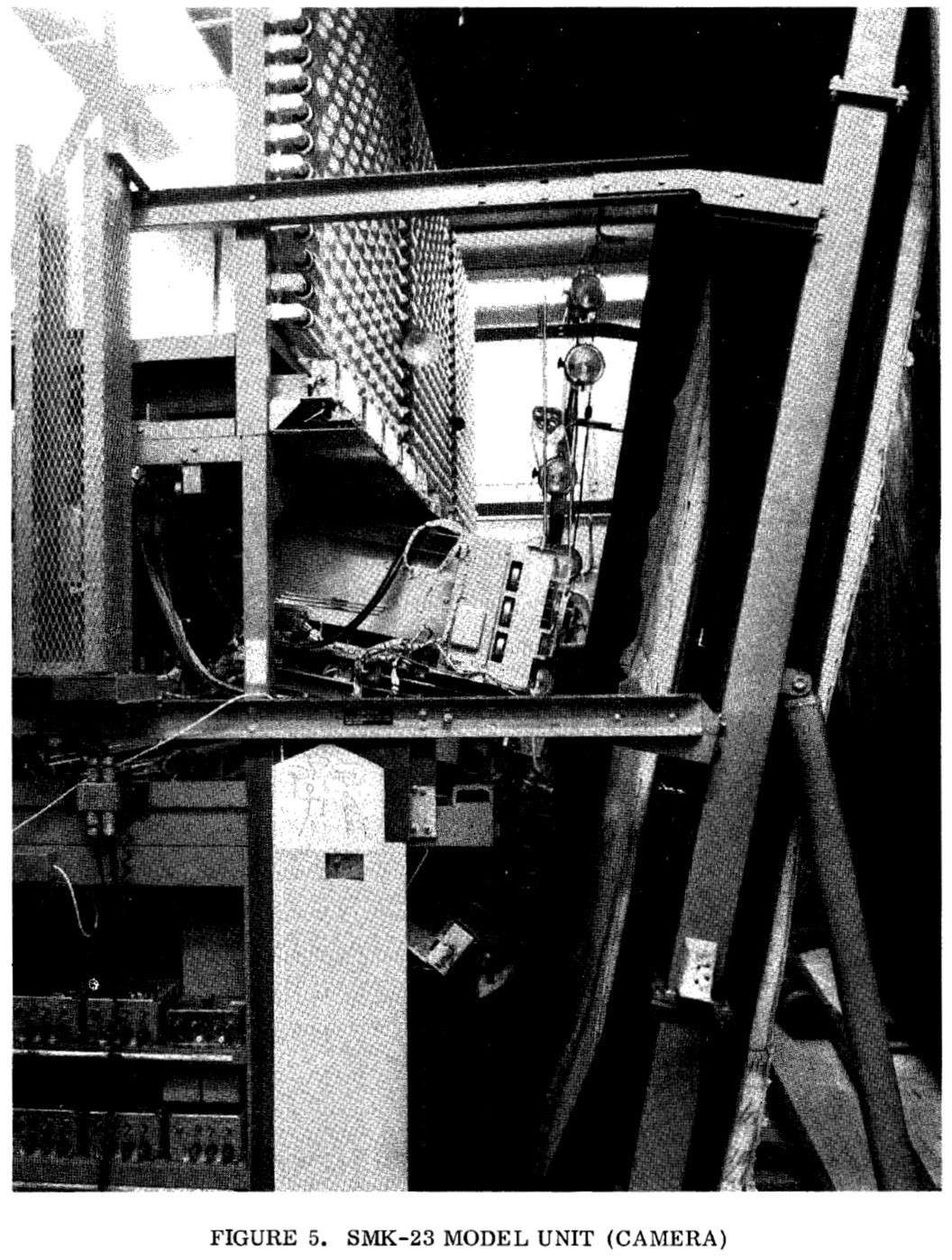
https://2img.net/h/i276.photobucket.com/albums/kk10/lunacognita/SMK-23LRVSimulatorcameralampsandsur.jpg
SMK-23 LRV Simulator Schematic

https://2img.net/h/i276.photobucket.com/albums/kk10/lunacognita/SMK-23LRVsimulatorschematic.jpg
"LOLA" Simulator - Lunar Orbit & Landing Approach
Video Description by LunaCognita
"Project LOLA or Lunar Orbit and Landing Approach was a simulator built at Langley to study problems related to landing on the lunar surface. It was a complex project that cost nearly $2 million dollars.
In "Spaceflight Revolution: NASA Langley Research Center From Sputnik to Apollo," James Hansen wrote:
"This simulator was designed to provide a pilot with a detailed visual encounter with the lunar surface; the machine consisted primarily of a cockpit, a closed-circuit TV system, and four large murals or scale models representing portions of the lunar surface as seen from various altitudes. The pilot in the cockpit moved along a track past these murals which would accustom him to the visual cues for controlling a spacecraft in the vicinity of the moon. Unfortunately, such a simulation -- although great fun and quite aesthetic -- was not helpful because flight in lunar orbit posed no special problems other than the rendezvous with the LEM, which the device did not simulate. Not long after the end of Apollo, the expensive machine was dismantled."
http://www.nasa.gov/centers/langley/multimedia/project-lola.html
"LOLA was the first lunar simulator developed by NASA/Langley during the early run-up to Apollo. They were putting the finishing touches on this simulator back while Project Mercury was still flying in fact - and the thing cost the taxpayers over 2 million bucks (a decent chunk of change today and an absurdly big sum back in the early 1960s for something like this!).
LOLA was the first real lunar mission simulator designed to provide the astronauts with a proper visual representation of the Moon as seen from up close in lunar orbit at various altitudes and viewing angles above the lurain. This particular clip shows LOLA's lunar surface rear-projection video display doing it's thing during a Lunar Orbit Insertion (LOI) simulation that was using what in LOLA-speak was called "Model #1" - a 20-foot-diameter spherical terrain model of the entire Moon that was mounted on a rotating base. Model #1 was the lowest-resolution of the four different lunar surface "models" that the LOLA simulator utilized, with a scale of one inch equaled to nine miles of lunar surface distance. Model #'s 2, 3 and 4 were essentially progressively scaled sectionals of the lunar surface in full relief that focused closer and closer onto a specific target area, down to a scale of about one inch equaled to just 200 feet on Model #4.
You can see in this clip that in addition to the lunar surface being modeled, the LOLA system also used a front-projected four-axis starfield generator that used a pair of starballs to attempt to create the desired celestial effects. This starfield generation system being used here was an early version, and it's capabilities became much improved upon in the later sim generations that followed LOLA."
"This is a photo from 1967 showing the field-of-view that the Infinity Optical Display System was capable of providing in the simulators. In this case here, the simulator in question was the LM Dynamic Crew Procedures Trainer at NASA/JSC in Houston. It is worth taking note of the starfield that is also being displayed here in this simulation image. They certainly improved upon the capabilities of the starball projectors used here, and that was a vital requirement for the simulators to have since the astronauts were going to be required to program their CSM and LM navigation platforms using star sightings throughout the flight to calibrate the system and ensure they were on course"
LM Dynamic Crew Procedures Trainer
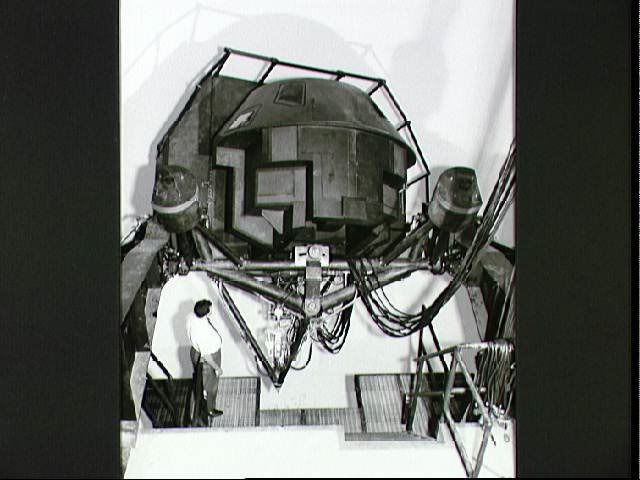
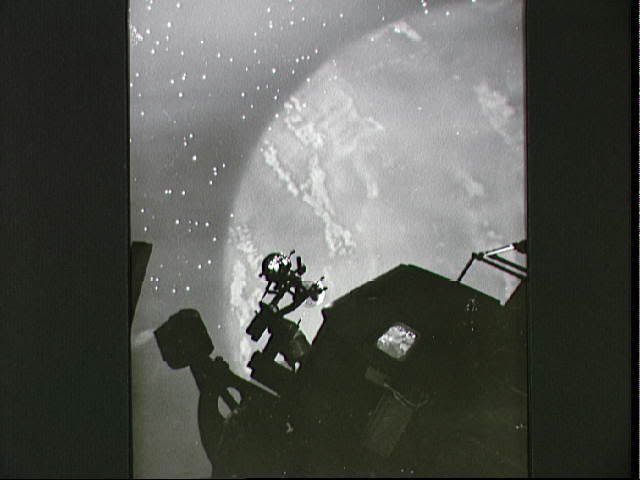
Apollo LMS Simulator & Images
Description by LunaCognita,
"Here are a few images taken through the window of the Apollo LMS simulator, showing the cockpit view of the lunar surface model that was provided to the astronauts for the practicing of approach/descent procedures. The view the Commander saw in the LMS simulator gave him a 110-degree field-of-view from the cockpit, with the simulated scene being displayed via what was called the Infinity Optical Display System, an image projection system that utilized optical reflective techniques to create the desired display of the simulated lurain features in the spacecraft windows. These particular examples here are showing the simulated view of the lunar surface during LMS approach into the Apollo 15 LZ at Hadley Rille, starting at 5000 feet above the surface, then 3000 feet, 1000 feet, and 500 feet."
LMS - view from 5000 feet
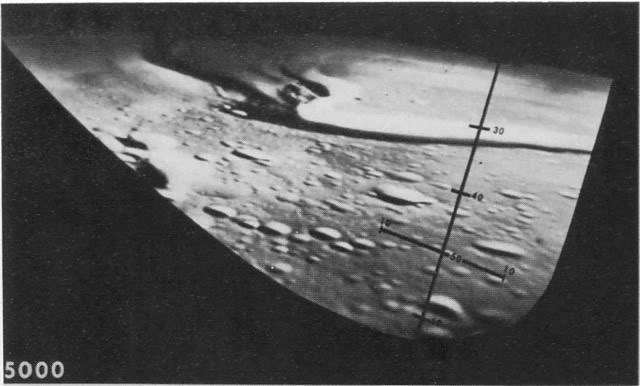
LMS - view from 3000 feet

labled - https://i.servimg.com/u/f80/16/99/98/32/3000ft10.gif
LMS - view from 1000 feet
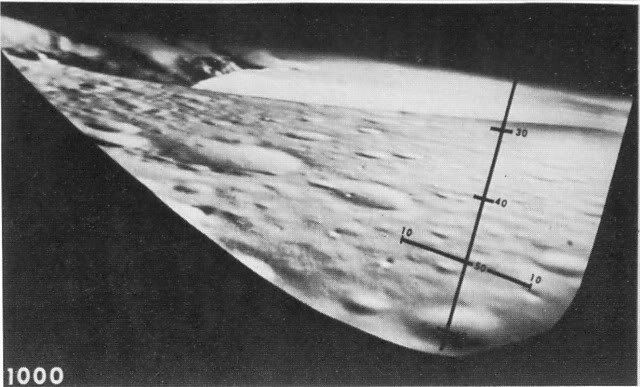
labled - https://i.servimg.com/u/f80/16/99/98/32/1000ft10.gif
LMS - view from 500 feet

"When it came to simulating rendezvous, docking and stationkeeping procedures during Apollo, NASA typically represented the target vehicle using scale models built around a three-gimbal control system that provided axis-change capability for the target. The visual data was fed to the crew via a CCTV system, with the LMS Simulator relying on a one-eightieth scale model of the CSM for longer range rendezvous procedures, and then a one-twentieth scale high-detail model for the more up close and personal stationkeeping stuff. Range-changes and closure/departure rates were simulated using several techniques, including physically moving the camera system towards or away from the target model on a track&carriage assembly, as well as exploiting a "raster shrinking" technique that supplemented the physical movement of the camera.
During Project Gemini, NASA actually experimented with a digital display system for rendezvous training that was called the EIG - "Electronic Image Generator" - which worked in conjunction with the Infinity Optical Display System to provide a basic 3-D computer-generated model of the target vehicle on the CRT for the Commander to take his visual cues from. The EIG was also used during the Apollo Program in the LMPS (Lunar Module Procedures Simulator) and the CMPS (Command Module Procedures Simulator), with those two sims both running off the same computer and filmstrip display system. There were actually 11 different simulators used during the Apollo program to train the astronauts, and the visual display techniques employed in those simulators really was pretty darn impressive, and for the most part the sims earned high praise from the astronauts. NASA's simulation capability evolved very quickly during the late-1960s and early-1970s, with significant improvements in the visual display systems - particularly when it came to image brightness capability of the IODS projectors - being updated throughout the course of the Apollo Program. All that simulation tech developed for the public space programs was obviously exploited by the DoD as well, using it to train crews in their classified space program operations, as well as modifying the tech for inter-atmospheric flight simulation development as well." Images and Information courtesy of LunaCognita, see post on Above Top Secret.com
Lunar Module Simulator
Various Images of Simulator Components

link - http://www.nasa.gov/centers/langley/multimedia/project-lola.html

http://www.thelivingmoon.com/45jack_files/02archives/Apollo_Reality.html

https://2img.net/r/ihimizer/img515/168/f1fded6d5527d63b729c707.jpg
Forced Perspective Photography
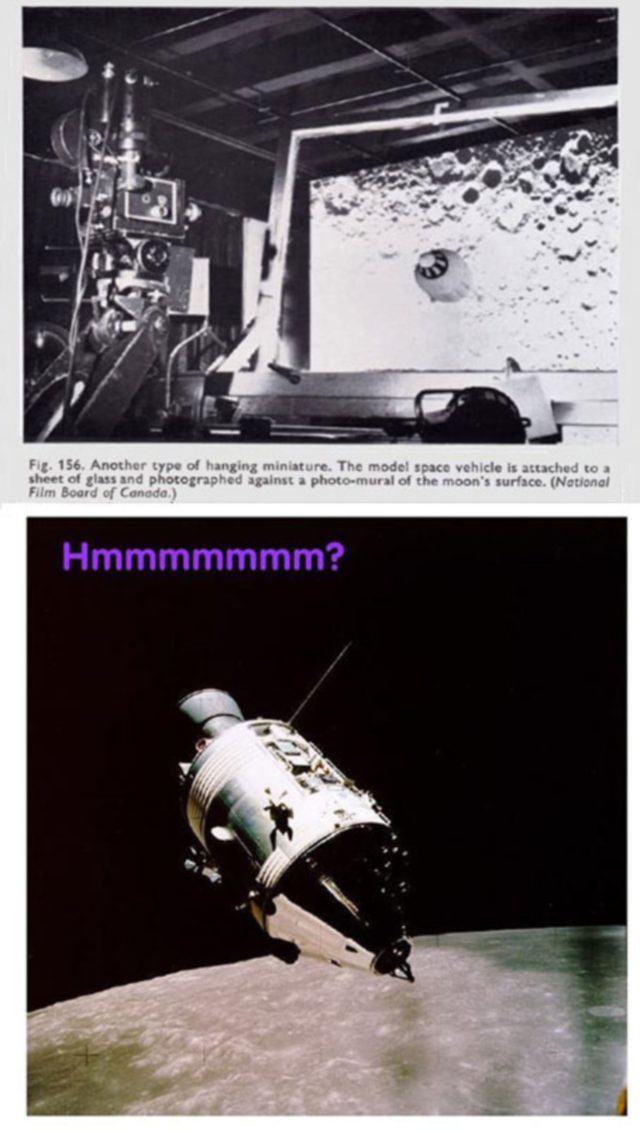
http://www.aulis.com/jackstudies_6.html
Moon Model

Moon Stage
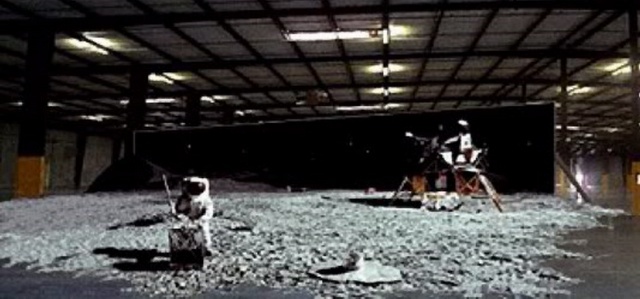
Moon Landing Simulation
Last edited by Admin on Wed Nov 25, 2015 10:51 pm; edited 2 times in total (Reason for editing : image links replaced)

Admin- Admin
- Posts : 1462
 Re: Apollo Lunar Mission Simulators
Re: Apollo Lunar Mission Simulators
Never seen that before!1969 CBS Live Broadcast of Moon Landing & Studio Simulation

Here's some more information & pictures on the LOLA:
The (...) simulator which requires detailed description is the LOLA (Lunar Orbit and Landing Approach) simulator, which is illustrated on these pages [see below]. With the aid of a system of four models of the lunar surface to various scales which television camera's scan, the astronauts enclosed within a mock up of the lunar module have a particularly realistic view of the surface of the moon as it appears from altitudes of 200 miles to 150 ft.
Oblique approaches and vertical descents can both be simulated with this. The light conditions are also simulated. Light can be provided, both by transparency and by incident beams, in intensities corresponding to various positions of the sun.
These simulators will provide great assistance for the astronauts who will be the first to set foot on the moon. But the astronauts, in their turn, will obtain valuable data which will permit the production of new and more complete, accurate and realistic simulators, and so further advance the training of 'lunauts' and prepare them for new conquests.
Source: Paul Hamlyn, The Encyclopdia of Space (1968) - link.
The drawing [above] gives a general view of the LOLA (Lunar Orbit and Landing Approach) simulator, the various models of which enable realistic views of the lunar landscape to be projected on to a screen for the astronauts. Each model (in the order 1 to 4) shows a portion of the moon drawing nearer and nearer.

LOLA Model #1 - large image.

LOLA Model #2 - large image.

LOLA Model #3 -large image.

LOLA Model #4 - large image.

Max Peck- Posts : 127
 Re: Apollo Lunar Mission Simulators
Re: Apollo Lunar Mission Simulators
Wow Max those are Excellent !
It's defintely interesting seeing the color images.
Thanks for posting and please add more if possible
It's defintely interesting seeing the color images.
Thanks for posting and please add more if possible


easynow- Posts : 790
 Re: Apollo Lunar Mission Simulators
Re: Apollo Lunar Mission Simulators
Thank you sir! These pictures came out really well so will definitely be posting more. I'm not sure if I have anything else on the simulators though.Wow Max those are Excellent !
Thanks for posting and please add more if possible.
...Oh no, here we go again...It's defintely interesting seeing the color images.

What gets me thinking as well is what they say about the simulation of lighting conditions using transparencies. Does that sound familiar to you? I don't want to open that can of worms here but I'm just saying - read this information people! Take a good look at the pictures & videos, and consider the possibilities.
Thank you, easynow, for posting this topic; I think it is an important piece of the puzzle.
Cheers,
MP

Max Peck- Posts : 127
 Re: Apollo Lunar Mission Simulators
Re: Apollo Lunar Mission Simulators
What happened to the LMS simulator approach view images that were posted up here? There were a couple of them missing already but now they are all gone... 
They were removed from imageshack and I noticed in my own account that two of my old photographs from a couple of years ago have been removed as well. It's not a problem right now because they aren't used on the forum anywhere but perhaps it's time to start looking somewhere else to store my forum images...?!
Max
They were removed from imageshack and I noticed in my own account that two of my old photographs from a couple of years ago have been removed as well. It's not a problem right now because they aren't used on the forum anywhere but perhaps it's time to start looking somewhere else to store my forum images...?!

Max

Max Peck- Posts : 127
 Re: Apollo Lunar Mission Simulators
Re: Apollo Lunar Mission Simulators
Your welcome and thanks again for sharing the images with everyoneThank you
Yes very green indeed but the question is why is it green ?It looks kind of green now....?
No and I'm not really sure what "using transparencies" means.What gets me thinking as well is what they say about the simulation of lighting conditions using transparencies. Does that sound familiar to you?
Just a guess but does that mean the "model" has a light source inside and is internaly lit producing an illuminated surface simulation ? Not sure really but I'd like to know more about it.
I replaced all the images using a different image host and obviously imageshack is not reliable and I won't ever use that site again. There are some other threads with missing images too and I have to do the same thing to them which is alot of work but since they're important topics it will be time well spent.What happened to the LMS simulator approach view images that were posted
Yes probably a good idea to find an alternative and also save the files incase the new image site you choose has problems later on.perhaps it's time to start looking somewhere else to store my forum images...?!
Here's an interesting picture of a Moon stage

Thanks Max for the replies and the images


easynow- Posts : 790
 Re: Apollo Lunar Mission Simulators
Re: Apollo Lunar Mission Simulators
Max Peck wrote:
Here's some more information & pictures on the LOLA:
The (...) simulator which requires detailed description is the LOLA (Lunar Orbit and Landing Approach) simulator, which is illustrated on these pages [see below]. With the aid of a system of four models of the lunar surface to various scales which television camera's scan, the astronauts enclosed within a mock up of the lunar module have a particularly realistic view of the surface of the moon as it appears from altitudes of 200 miles to 150 ft.
Oblique approaches and vertical descents can both be simulated with this. The light conditions are also simulated. Light can be provided, both by transparency and by incident beams, in intensities corresponding to various positions of the sun.
These simulators will provide great assistance for the astronauts who will be the first to set foot on the moon. But the astronauts, in their turn, will obtain valuable data which will permit the production of new and more complete, accurate and realistic simulators, and so further advance the training of 'lunauts' and prepare them for new conquests.
Source: Paul Hamlyn, The Encyclopdia of Space (1968) - link.
The drawing [above] gives a general view of the LOLA (Lunar Orbit and Landing Approach) simulator, the various models of which enable realistic views of the lunar landscape to be projected on to a screen for the astronauts. Each model (in the order 1 to 4) shows a portion of the moon drawing nearer and nearer.[url= https://2img.net/r/ihimg/photo/my-images/211/sim1enhancedsmaller.jpg /][/url]
LOLA Model #1 - large image.
LOLA Model #2 - large image.
LOLA Model #3 -large image.
LOLA Model #4 - large image.
Hey Max, ... it looks like the images are gone or not showing up.
Any way you can repost those images ?
Hope to hear from you. Thanks

Edit to add:: Nevermind
I was able to edit the image link [center][url= https://2img.net/r/ihimg/photo/my-images/211/sim1enhancedsmaller.jpg /]
 [/url]
[/url]and download the smaller versions of the images but still cannot get the larger versions.

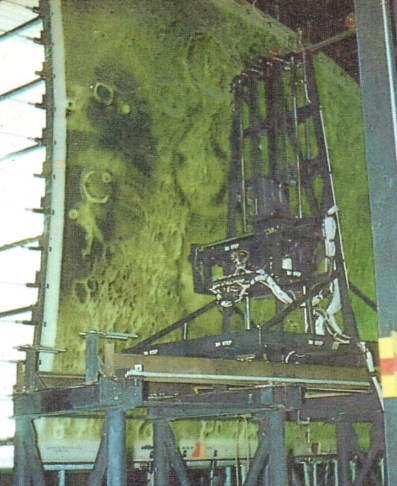
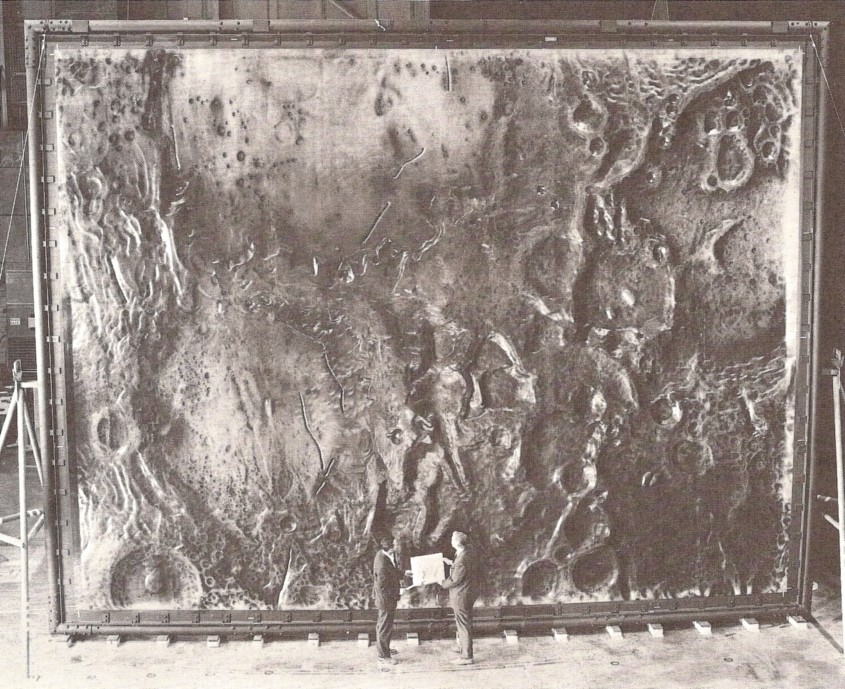
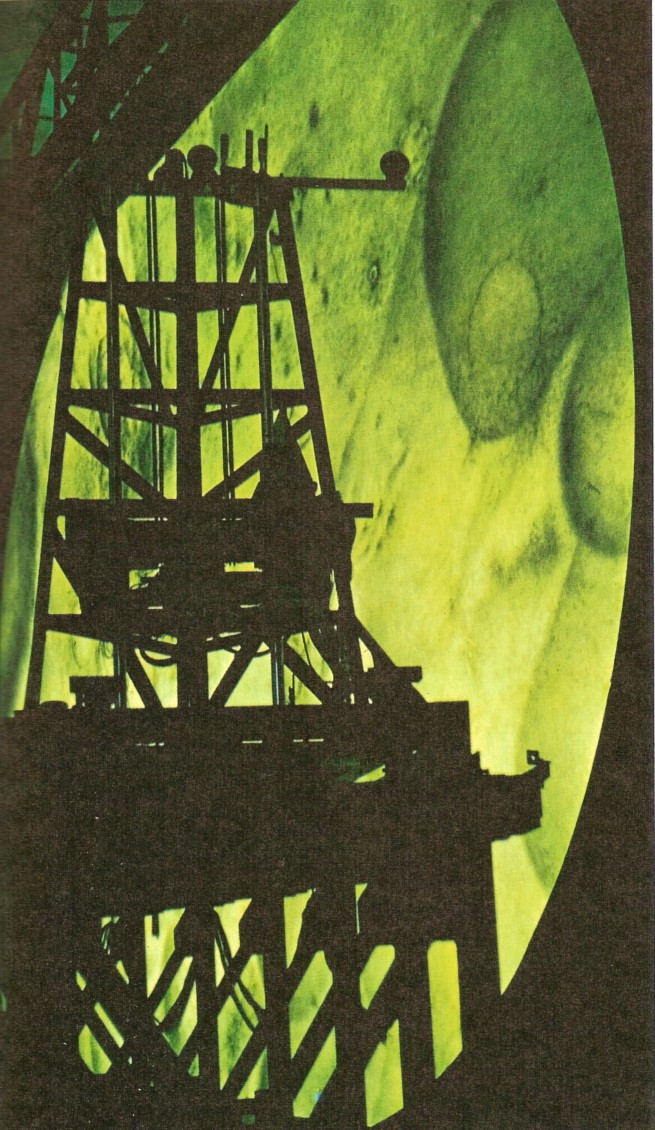

easynow- Posts : 790
 Similar topics
Similar topics» NASA Mission Seeks Lunar Air
» Apollo 11 - Secret Mission - Bible on the Moon
» Apollo 12 - Mission Insignia comparison - sanitized vs. unsantized
» GCTA-TV/Hasselblad comparative analysis - "Cernan Shoots The Earth" - Apollo 17 lunar surface EVA2 @ "Nansen"
» The Apollo 17 "Hand Job" - Examining Cernan & Schmitt's claims of hand injuries suffered during their mission
» Apollo 11 - Secret Mission - Bible on the Moon
» Apollo 12 - Mission Insignia comparison - sanitized vs. unsantized
» GCTA-TV/Hasselblad comparative analysis - "Cernan Shoots The Earth" - Apollo 17 lunar surface EVA2 @ "Nansen"
» The Apollo 17 "Hand Job" - Examining Cernan & Schmitt's claims of hand injuries suffered during their mission
Page 1 of 1
Permissions in this forum:
You cannot reply to topics in this forum
 Home
Home Gab Social
Gab Social Twitter
Twitter Youtube
Youtube


